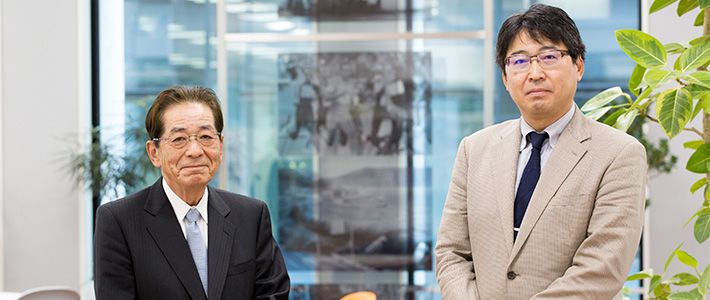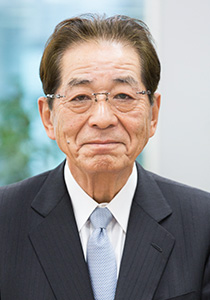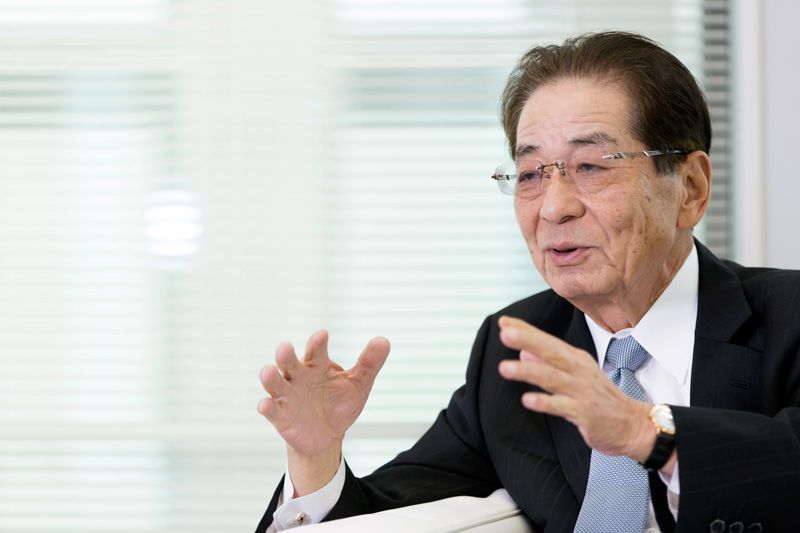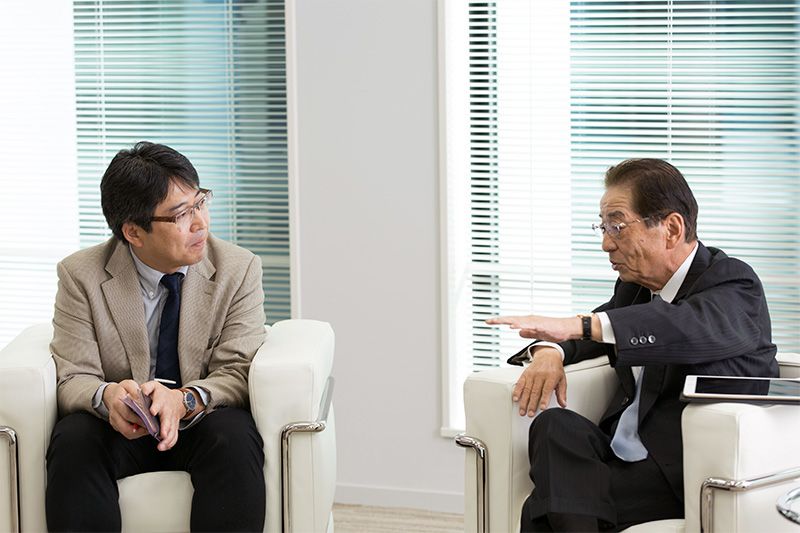
Working with a Powerful China: An Interview with Former Chief Cabinet Secretary Sengoku Yoshito
Politics- English
- 日本語
- 简体字
- 繁體字
- Français
- Español
- العربية
- Русский
(For the first part of this two-part interview, see “The Senkaku Crisis in Perspective.”)
SENGOKU YOSHITO Under President Donald Trump, it’s becoming difficult for the rest of the world to look to the United States for leadership. Washington is relying on military and economic clout to whip other countries into line, but from the standpoint of soft power, including a commitment to principles like democracy and human rights, there’s a growing tendency, in Europe in particular, to distance oneself from the United States. On the other hand, if China is claiming to be part of a Group of Two superpowers [alongside the United States] it has to offer something in the way of common values, especially to the developing world, in addition to its economic and military power.
KAWASHIMA SHIN At the latest National Congress of the Communist Party, Xi Jinping continued to talk about international leadership in terms of a “win-win proposition,” a “partnership,” and a “common destiny,” but he still hasn’t offered any inducements beyond economic and military ones. There are some signs that Chinese ideas about governance and a cashless society are spreading into Southeast Asia. But it’s not as if other Asian peoples regard China as the kind of country they’d like to live in.
In spite of China’s hard power, its influence in terms of culture, values, and general appeal is still quite weak. That’s the kind of power China desires above all else, but it just can’t seem to get there. The fact that Xi Jinping set 2050 as the target year for achieving global superpower status suggests that China’s leaders realize this is something that will take some time.
Significance of “Xi Jinping Thought”
SENGOKU Based on the example of Japan’s rapid growth after World War II, or in the Meiji era [1868–1912] for that matter, we expect the impulse toward greater freedom to assert itself once the state has achieved its basic economic policy goals. But China just seems to be striving toward greater wealth.
KAWASHIMA I think there’s a lot of food for thought in the remarks Xi Jinping delivered to the latest National Congress. Why has “Xi Jinping thought” been elevated to the level of official Communist Party doctrine? I think it’s because Xi has redefined the basic contradictions China needs to resolve as a state. Since 1981, in keeping with Deng Xiaoping’s economic reforms, the party’s official ideology has focused on the need to close the gap between the material needs of the people and the nation’s productive forces. Xi Jinping has shifted the goal posts to a vision of the good life in a “beautiful China.” For that, the nation needs to develop further, and in a more balanced manner. Xi is calling on the Chinese to embrace a more balanced, rewarding standard of living.
Ordinarily, this would signal a shift to a liberal, postmodern, democratic society. But in China, you can’t just say, “Okay, everyone, go do your own thing under the banner of multiculturalism.” Still, the lack of liberty in a society on the brink of material satiety strikes us as a fundamental anomaly. Building a mature, affluent society without reforming the current political system would be a historic challenge.
There’s no precedent for such an achievement among today’s advanced industrial countries. If China can offer a model for maintaining authoritarian rule even as society reaches an advanced level of affluence and maturity, it could have a real influence on the policies of developing and emerging countries where democracy hasn’t taken hold. But that’s a big “if.”
China Diplomacy in the Post-ODA Era
SENGOKU The path to the normalization of relations between Japan and China in 1972 was not an easy one. A lot of people on both sides worked very hard to establish semiofficial ties at a time when there was no legal relationship between our countries. That included the development of “LT trade”(*1) at the initiative of Liao Chengzhi and Takasaki Tatsunosuke, sports diplomacy, and so forth. At one time, the dominant sentiment in Japan was one of gratitude to those who built the bilateral relationship out of nothing, but feelings have changed over time.
Today, I think there’s a great deal of ambivalence toward China among Japanese business leaders. The modernization of China’s steel industry, for example, began with the construction of Baoshan Iron and Steel in Shanghai, which was made possible by Japanese assistance. Today, China’s steel industry accounts for half of the world’s production capacity, and domestic overproduction is creating headaches for everyone. Japan’s steel makers complain that dumping by China is making it nearly impossible for them to do business—and that after all Japan did for China in the past.
Beginning around 1990, under the Takeshita [Noboru] cabinet, Japanese politicians began to talk about cutting off official development assistance to China. Altogether, Japan has channeled more than 3 trillion yen in ODA into China. Mind you, China has paid back all its yen loans. Anyway, this isn’t something either side talks about much at the government level.
KAWASHIMA Japan stopped investing in new ODA projects in China in 2008. That was right about when bilateral ties were at their peak. Under the Fukuda [Yasuo] and Asō [Tarō] administrations, Japanese and Chinese leaders were meeting in one capacity or another a dozen times a year. Then the flow of new ODA stopped, and soon after that, the DPJ came to power.
Japan’s ODA projects in China fostered active exchange of all kinds of personnel, and those contacts created a pipeline between Japan and China. Under the DPJ, the government suddenly had to manage China diplomacy without the help of ODA. I get the impression that you were deeply involved in efforts to build personal connections and lines of communication with the Chinese during that critical period.
SENGOKU I visited China for the first time in 1990, when I was elected to the Diet. A lawyer friend of mine was involved in a small grant-aid project to dig wells and provide running water in Huai’an, Jiangsu province, and he wanted me to attend the inauguration ceremony. That was the first time I had anything to do with China.
Building a network of relationships in China isn’t easy because the country’s so big, and there are so many government officials to deal with. So, ultimately you end up dealing with party officials in the CPC’s International Liaison Department. And while they’re very affable and happy to talk to you, they don’t necessarily tell you what China’s leaders are really thinking.
KAWASHIMA In the past, there was also a fair amount of inter-party diplomacy outside of official government channels—for example, between the CPC and current and former members of the Japan Socialist Party.
SENGOKU Nikai [Toshihiro] has played the same sort of role within the LDP. But I’m not sure how effectively our China hands can function now that Xi Jinping has pushed out most of the key figures from the Jiang Zemin era, because those were the officials with whom Japanese politicians had the strongest connections.
Toward a New Era of Japan-China Cooperation
KAWASHIMA It seems to me that there was a period when Japan and China enjoyed good relations at the unofficial and semiofficial level based largely on personal goodwill, including the LT trade you mentioned a moment ago. Then we entered the era of bilateral ties rooted in economics, including ODA. And now we’re in a third era, but we still haven’t figured out what sort of relationship to build going forward. The dawn of that third era was probably right around 2009, when the DPJ took over.
SENGOKU It’s occurred to me lately that during all those years of friendly Japan-China relations, Japan was involved in a variety of initiatives in the healthcare sector going back decades—donating to Chinese hospitals, sending Japanese doctors to China, accepting Chinese student nurses into training programs here in Japan, and so forth. But partly owing to its huge population, China never developed a system like Japan’s, in which everyone, rich or poor, can get good healthcare wherever and whenever they need it. It seems to me that our healthcare and long-term care systems represent an area in which Japan can make another major contribution to China’s development—with know-how, as opposed to infrastructure and equipment.
KAWASHIMA As I was saying a moment ago, Xi Jinping has shifted the focus of China’s development from material prosperity to what you might call a Chinese vision of “true affluence.” I think this could present a unique opportunity for Japan. When China set out to achieve material prosperity in the 1980s, it looked to Japan as its economic mentor. Then, as China achieved its own material prosperity, it began looking down on Japan. But now that the nation has set its sights on true affluence, it might start to appreciate what Japan has to offer, not only in the area of healthcare but also in terms of dealing with environmental problems.
SENGOKU It seems to me that Japan’s affluent, stable, safe society is a positive role model, if you will, an object of admiration to people in China, as in the rest of Asia. If that’s the case, then let’s proactively cooperate in the development of a healthcare system and the professionals needed to support it. This is bound to enhance the perceived value of each individual, which in turn is likely to foster broader recognition of the need for a society that heeds the voices of its citizens. That could ultimately yield answers to a whole range of problems.
KAWASHIMA That’s a fantastic idea. The more affluent the Chinese become, the more they’ll value life and appreciate the obvious importance of good healthcare. Furthermore, interchange in this field is bound to foster a deeper appreciation of the dignity of human life. And that could help put the issue of human rights on the table, even under the current system of government.
But we need to pursue a comprehensive healthcare cooperation program, not simply provide technical assistance. With that as a starting point, a lot of the tensions between Japan and China might begin to resolve themselves.
(Originally published in Japanese on November 23, 2017, based on an October 26 interview conducted at the Tokyo studio of Nippon.com. Photographs by Kawamoto Seiya.)
(*1) ^ Semiofficial trade conducted in the 1960s in accordance with the 1962 Memorandum Concerning Sino-Japanese Long-Term Comprehensive Trade, also known as the LT Trade Agreement.—Ed.


